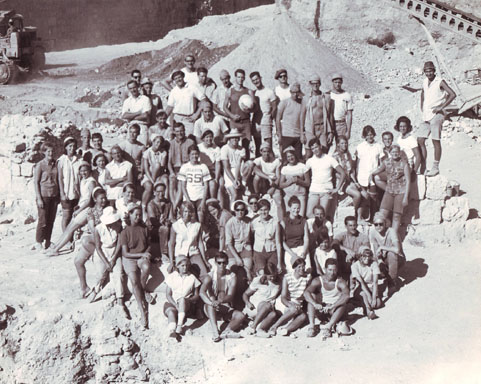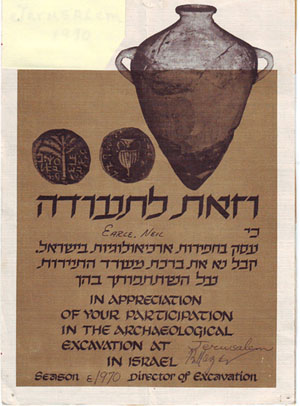Love at First Site
By Neil Earle
The other night my wife, Susan, and I were watching a KDOC-Los Angeles PBS special narrated by Yitzhak Pearlman on the land of Israel.
The photography was superb and the Mediterranean never looked so blue and the deserts so bare. As we whisked by camera through Tel Aviv and Jaffa and the Negev my wife and I were seized by strong feelings of nostalgia for what we both felt was the most eventful summer of our lives.
We were watching this fine travelogue in our adopted home town of Duarte, California almost 40 years to the day after we had both returned to England from the Temple Mount Archaeological Project in Jerusalem. Nicknamed “the Big Dig” it was led by Professor Benjamin Mazar and sponsored by the Israel Exploration Society, Hebrew University and our alma mater at the time, Ambassador College. Two years later we were married – but not just us. That is part of the story that I hope you will want to hear.
Interfacing History
It happened like this.
After the Israelis captured the Temple Mount area of Old Jerusalem in June, 1967, it finally became expedient to excavate the complex that holds the Jewish Wailing Wall, the gorgeous Dome of the Rock and the Al-Aqua Mosque – the last two being among the holiest sites in Islam. In 1968 Benjamin Maser was placed in charge of this biggest “dig” in Israel at the time. The Temple Mount was important because it housed both Solomon and Herod’s Temple (or Second Temple) and was not far from the City of David, the Biblical “Zion” where David had his capital. The political implications of this project were – and are – considerable.
 Neil Earle, second from left, digging underneath Al-Aqsa Mosque beneath the Temple platform.
Click to enlarge.
Neil Earle, second from left, digging underneath Al-Aqsa Mosque beneath the Temple platform.
Click to enlarge.However, this is not our story.
It so happened that a graduate of Ambassador College in Pasadena named Raymond Dick was working in Jerusalem by 1967 and had become friendly with Dr. Mazar. Knowing how archaeologists are always interested in funding, Ray Dick arranged for representatives from Ambassador College in Pasadena, California (now Grace Communion Seminary) to meet with the Israelis. Everything clicked and in the summer of 1969 students from the three Ambassador campuses – Pasadena, California, Big Sandy in Texas and Bricket Wood (20 miles north of London) showed up as student volunteers.
The next summer, 1970, Ambassador sent 70 students – including my wife, Susan, from Texas and yours truly from the British campus. Everyone got along famously, toiling gladly in the heat for a dollar a day (but free tuition that next semester). We not only toured the land, popped out on day tours occasionally, studied Hebrew and geography and actually lived in the Old City among our Arab friends in a fine establishment capably run by a Palestinian family (the Orient House Hotel) but…we actually made an important archaeological discovery (you were probably wondering!). Big John Turner from the Pasadena campus via Kansas uncovered a 3-4 foot stone column that had an inscription on it. Inscriptions are like gold for archaeologists and this one read, in part:
Imp Vespasian
It apparently was erected by the Roman Tenth Legion in honor of Roman Emperor Vespasian (69-79 C.E.) by his son Titus – supporting literary evidence that both generals were on the site.
The find by this “young Pasadena archaeologist” made The Jerusalem Post the next day.
Love Among the Ruins
Now look. If you throw 70 healthy young men and women from America, the British Commonwealth and elsewhere together for eight weeks – something’s gotta give. It did. Susan estimates that of the 70 students no fewer than 12 marriages came out of that summer eventually. It was love at first site – our first archaeological site. Unfortunately some of those marriages did end unfortunately and some of our friends have since deceased (including most recently the kindly giant John Tuner) but overall the record was pretty good.
Even today when they ask how my wife and I met we get a chance to imaginatively revisit that special summer of 1970. It never grows old. It really does something to you to live and work and eat and sleep where so much Biblical history unfolded. I remember looking up occasionally at the Mount of Olives and thinking – “That’s where Jesus ascended and where Messiah will return – wow!”
Digs in Review
The next year, 1971, another group of Ambassador Diggers uncovered the Hulda Gate or Steps east of the walls erected by the Turks in the 1500s. It was a pretty famous find. Up that southern approach to the temple walked Jesus, Peter and John on their way to worship and to expound the new message Jesus was bringing to the world.
Just for the record it might be beneficial for our readers to review some of the most important artifacts that have been uncovered relating to the early years of the New Testament church. As a pastor I am often asked this when I present on Palestinian Archaeology. Most of these are since the 1960s and can be found in Paul Eddy and Gregory Boyd’s book The Jesus Legend: a Case for the Historical Reliability of the Synoptic Jesus Tradition. John Dominic Crossman and Jonathan L. Reed helpfully compile the “Top Ten Discoveries” in their book Excavating Jesus. Here are some of the most famous and sometimes unheralded “finds:”
- In 1962 a Latin inscription was found at Caesarea (on the coast) bearing the name “Pontius Pilate.” How clear can you get? This man really existed.
- Numerous coins found in the Galilee area minted by Herod the Great (37-4 BCE) show no human faces on the coins, confirming the Jewish sensitivity to idolatry as we might expect from reading the Synoptics – Matthew, Mark and Luke.
- A jar with a cross discovered in Bethsaida dating from before 67 C.E. confirms both a Christian presence in this town and its geographic location north along the Sea of Galilee.
- The entombed remains of a first-century crucified man found in burial caves northeast of Jerusalem in 1968 confirm the grisly details of that penalty. The right heel of the man had been pierced with a 4½ inch nail. It also showed that victims of capital crimes could be granted a proper burial as John 19 indicates of Jesus.
- In 1986 a sunken fishing boat from the first century was found in the Sea of Galilee. With measurements of 8 by 26 feet it could easily hold 13 people.
- In 1990 an ornate limestone ossuary was discovered in a burial cave south of Jerusalem with the name etched in Aramaic “Caiaphas”. It is hard to deny that this is not the priestly bones of the high priest who condemned Jesus.
- The very house of Simon Peter may have been excavated in Capernaum. Christian prayers etched on the walls of this modest first-century house date from the second century. These indicate this was a special structure for church members. This may have been Jesus’ base of operations in Galilee (Mark 1:29-35).
- The rock slab inside the Church of the Holy Sepulcher is now more and more attested as the spot where Jesus was buried.
- What has been called the High Priestly Quarters was uncovered in 1970 on the western hills overlooking the Old City. It contains rich and ornate remains – frescoes, glass objects, and stucco details that indicate the upper crust lived there.
Of course for us in 1970 and afterwards, the rocks themselves were crying out – every day for eight weeks. Some of those massive Herodian stones that still undergird the Southwest corner of the Temple Mount down from the Wailing Wall measure 40x10 by fourteen feet thick. They rose from street level about 100 feet high and are all the proof you needed that Herod’s Temple really was something. Even Jesus’ own disciples were dazzled (Matthew 24:1-2). These remains were massively spectacular and we were digging near them every day. Something happened here and what it was became exactly clear.
No, we’ll never forget our summer in Israel. Archaeology has been fascinating for my wife and I ever since. I usually preach and teach on this subject of Palestinian or Iraqi or Persian remains every chance I get and especially on our local cable station, DCTV Duarte here in Southern California. Well, that’s it. Shalom. Over and out. Thanks KDOC for the memories. We hope you enjoyed the tour.


